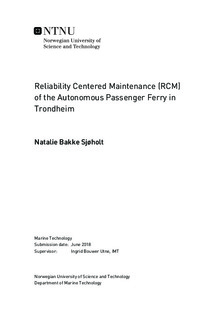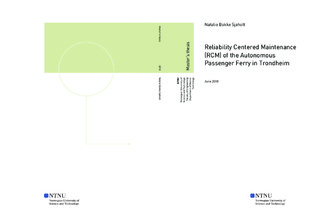| dc.description.abstract | This thesis make use of the RCM method to construct a maintenance program for an autonomous passenger ferry. The autonomous passenger ferry will work as a shuttle ferry in Trondheim, between Ravnkloa and Vestre Kanalkai. The idea is a on-demand ferry, push the button and the ferry will come shortly. The ferry will be designed to take maximum 12 passengers, have a crossing time of one minute and to be unmanned. Several challenges comes with the autonomy; will the ships be legal, will ship owners invest, what technology is needed. Before the project can be realized there are several aspects related to operation and maintenance that has to be solved. The Norwegian Maritime Authority states that autonomous ships needs to be as least as safe as conventional ships. This is tried accomplished through the maintenance strategy, which will identify critical components and failure modes and assign them with maintenance task, to reduce the consequences of the failures.
As mentioned, RCM is used to construct the maintenance program. This thesis makes use of the procedure from John Moubray, which is based on the standard SAE JA 1011. The focus is on maintaining the functions for the systems. The analysis is performed system for system. The seven questions from the standard is answered in a systematic way. Starting out by identifying the systems primary and secondary functions together with given performance standards. Next is the functional failures stated, which is based on the functions. A functional failure is when the system is no longer able to perform whats required. This is followed by a failure mode, effects and criticality analysis (FMECA) which is performed on a component level. Each failure modes criticality is assessed in the light of effects on safety, asset, environment and availability. To do this, classes ranging from one to five where five is catastrophic and one is insignificant has been used. Two of the most significant systems when it comes to the unmanned concept are the anti-collision and navigation system. Due to their importance an ETA and a FTA has been performed for both of them. Where the FTA focuses on total failure of the system, and ETA focuses on the damages to the passengers when a failure occurs. The analysis shows that there are low probabilities of a total failure in the two systems, much due to the redundancy.
Further, a maintenance task analysis is performed. Since the RCM aims to reduce maintenance costs, a maintenance task needs to be both cost effective and technically feasible. The costs calculations are performed by comparing hours available to do preventive maintenance before run-to-failure is more cost effective. The costs of run-to-failure includes loss of income, spare part costs, repair costs, injury costs and loss of reputation. The two last ones are the most significant ones. The cost calculation is only done for systems where it is needed. The maintenance task is divided in five: scheduled on-condition, scheduled discard, scheduled restoration, scheduled failure-finding and run-to failure. Where the first four are preventive maintenance tasks.
Most of the failure modes in the analysis received a high risk index, where over 55% of them are in the unacceptable area. Followed by this, there are a high use of preventive maintenance, with over 80%. The analysis performed has shown that the most critical systems are the navigation, anti-collision, propulsion and battery cooling system. These are critical in the light of the direct effects of the failures, but also the effects on loss of reputation as well. For such a new concept where new technology has been used, reputation will be important. The maintenance program suggested is grouped in maintenance packages with basis in the maintenance interval.
As mentioned before, the concept with unmanned passenger ferries is new. Consequently there are lack of information available. The systems identified in thesis are based on information given by the project manager. Where information was not available, relevant sources were used to first design the systems. Many of the failure modes, together with causes and maintenance, are based on manufacturers manuals. This includes equipment which is assumed to be chosen. It is not certain that it will or that all of the components will work together.
The master thesis will provide a framework for the maintenance plan. In addition, the plan must be implemented, and it is recommended to register failure and maintenance data when the ferry is operative. This will help in updating and implementing the plan. | |

